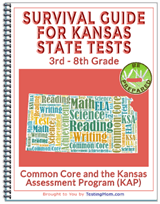It seems everybody loves a list, especially this time of year, whether it’s an obligatory best movies of the year or one as inane that predicts popular baby names for 2016,. In the spirit of the season that thrives on listicles while avoiding icicles, the following are 10 Things You Should Know About the New Federal Education Law, in no particular order of importance (and without those irritating pop-up ads!).
1. No Child Left Behind has been officially left behind.
The new law is known as the Every Student Succeeds Act(ESSA) and replaces the much maligned and unrealistic No Child Left Behind (NCLB). NCLB was due for reauthorization several years ago, but Washington gridlock put the kibosh on that, leading to the unintended consequence of unprecedented powers ceded to the U.S. Department of Education; powers that ultimately allowed federal bureaucrats to expand their influence over the states that gave rise to Common Core State Standards.
2. Common Core Standards.
 Speaking of Common Core, under the new law states will still be required to have “challenging” standards, but the feds will no longer be able to force states to adopt, or keep, Common Core. In fact, the law expressly prohibits the Secretary of Education from such shenanigans, as former Secretary Arne Duncan executed through the NCLB waiver process (which is also history!).
Speaking of Common Core, under the new law states will still be required to have “challenging” standards, but the feds will no longer be able to force states to adopt, or keep, Common Core. In fact, the law expressly prohibits the Secretary of Education from such shenanigans, as former Secretary Arne Duncan executed through the NCLB waiver process (which is also history!).
3. Testing.
 States are still required to test annually, but the law gives states the option to use more than one assessment to report student outcomes. The details are a little too wonky to present here and concerns have already been raised, but look for a blog post if the State Board of Education decides to use multiple tests. My guess is that they won’t, so testing of Kansas students will probably remain pretty much the same under the new law.
States are still required to test annually, but the law gives states the option to use more than one assessment to report student outcomes. The details are a little too wonky to present here and concerns have already been raised, but look for a blog post if the State Board of Education decides to use multiple tests. My guess is that they won’t, so testing of Kansas students will probably remain pretty much the same under the new law.
4. Low-performing schools and struggling students.
 States will still be required to address the lowest five percent performing schools and districts will be required to make plans for improving the outcomes of subgroups of students who are falling behind. Unfortunately, the school choice provision for those students stuck in failing schools appears to be weak, with too much emphasis on trying to make the school better instead of assuring the best education opportunities for the students.
States will still be required to address the lowest five percent performing schools and districts will be required to make plans for improving the outcomes of subgroups of students who are falling behind. Unfortunately, the school choice provision for those students stuck in failing schools appears to be weak, with too much emphasis on trying to make the school better instead of assuring the best education opportunities for the students.
5. Title I portability.
 One of the most hotly debated issues that didn’t make it into the law is the concept of Title I funding following the student. Title I is essentially federal dollars to schools with low-income students (similar in concept to the Kansas At-Risk program). Key congressional Republicans called for Title I funds to follow students if they changed schools, but congressional Democrats were opposed. Ultimately, it was the “devil is in the details” that doomed the idea. Apparently, the Republicans backed away when shown the complexities of administering such a plan.
One of the most hotly debated issues that didn’t make it into the law is the concept of Title I funding following the student. Title I is essentially federal dollars to schools with low-income students (similar in concept to the Kansas At-Risk program). Key congressional Republicans called for Title I funds to follow students if they changed schools, but congressional Democrats were opposed. Ultimately, it was the “devil is in the details” that doomed the idea. Apparently, the Republicans backed away when shown the complexities of administering such a plan.
6. The School Improvement Grant (SIG) program has been eliminated.
 The multi-billion dollar boondoggle that was created under NCLB to turn around low-performing schools was rightly abolished. The controversial program poured millions into poor performing schools with little or no positive results. For example, a multi-year SIG was granted by KSDE to a Topeka USD 501 elementary school that is scheduled to be closed pursuant to a district-wide reorganization. Seriously.
The multi-billion dollar boondoggle that was created under NCLB to turn around low-performing schools was rightly abolished. The controversial program poured millions into poor performing schools with little or no positive results. For example, a multi-year SIG was granted by KSDE to a Topeka USD 501 elementary school that is scheduled to be closed pursuant to a district-wide reorganization. Seriously.
7. The impact on teachers.
 ESSA will likely have little impact on the day-to-day life of a teacher. Perhaps the biggest change from what came down the pike from the feds is that states are no longer required to include student achievement as part of the teacher evaluation process. What was to be a pillar of the waiver conditions, tying evaluations to student outcomes, according to this report, never materialized. Ultimately, the states couldn’t enforce the requirement and the feds chose to look the other way.
ESSA will likely have little impact on the day-to-day life of a teacher. Perhaps the biggest change from what came down the pike from the feds is that states are no longer required to include student achievement as part of the teacher evaluation process. What was to be a pillar of the waiver conditions, tying evaluations to student outcomes, according to this report, never materialized. Ultimately, the states couldn’t enforce the requirement and the feds chose to look the other way.
8. States will have more control over education.
Overall, the feds have given back some of the control they usurped during the NCLB era. From testing to standards to accountability, the feds have widened the parameters in which state education systems operate pursuant to the new law.


9. There is still too much federal control over education.
The federal government usurped a great deal of education authority during the NCLB era. Despite the new law, the federal government continues to have too much influence over what is constitutionally a state function. From testing to standards to accountability, the feds’ parameters are still too wide.
10. Don’t expect much change in Kansas.
Regardless of federal overreach, educating students is still a state function. More than 90% of all education funding comes from within the state’s borders. Given the effort the State Board of Education has put into testing, the SBOE is unlikely to make any major changes in assessing and reporting student outcomes. And they will continue to monitor low-performing schools.
The best opportunity for change is in the arena of educational standards. The current College and Career Ready Standards are up for renewal in 2017, so now would be an excellent time to begin focusing on a transition from federally imposed standards to ones that better reflect the needs of Kansas students becoming successful.



